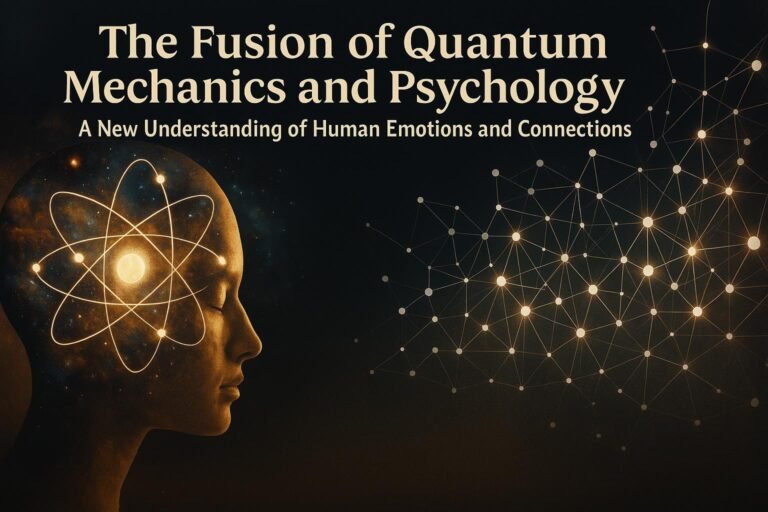The Fusion of Quantum Mechanics and Psychology: A New Understanding of Human Emotions and Connections
HomeQuantum PsychologyThe Fusion of Quantum Mechanics and Psychology: A New Understanding of Human Emotions and Connections

The fusion of quantum mechanics and psychology might initially sound like an abstract, intellectual exercise, but its value goes far beyond theory. This integration provides profound insights into the complexity of human emotions, connections, and consciousness. Quantum mechanics, often associated with particles, probabilities, and the mysterious behavior of subatomic elements, can help us understand the intricacies of the mind in ways that traditional psychology may not fully explain.
By drawing parallels between quantum concepts like the Schrödinger equation, quantum superposition, and entanglement, we can begin to see human emotions and relationships in a new light. In this blog post, we’ll explore how the fusion of these fields opens up a deeper understanding of emotional complexity and human connection.
One of the fundamental ideas in quantum mechanics is the Schrödinger equation, which describes how the quantum state of a system evolves over time. In simpler terms, it defines the possible states that a quantum system can exist in, highlighting the idea of superposition, where a system can be in multiple states at once until observed.
In the context of human emotions, we can see a parallel. Human emotions are rarely straightforward or deterministic. They often exist in a superposition of states, where we might feel multiple, even contradictory emotions at once. For instance, you can feel both love and frustration toward someone, or fear and excitement about a new opportunity. These emotions coexist, much like quantum particles in superposition.
As Plutchik (2001) emphasized, emotions are dynamic and complex, not limited to binary states. They fluctuate and shift depending on external and internal factors. The Schrödinger equation helps us understand that emotions aren’t fixed or determined until they’re “observed” or consciously acknowledged. Much like quantum particles, our emotional states can be fluid and probabilistic until they collapse into one feeling based on our self-awareness or experience.
This idea offers a new way to understand emotional uncertainty. When we struggle with our feelings, it’s often because we’re trying to label or pin down something that’s naturally fluid. Quantum psychology suggests that instead of forcing clarity, we can embrace the complexity and accept that our emotions might exist in multiple states simultaneously.
Quantum entanglement is another fascinating concept from quantum mechanics. It describes how two particles can become linked, such that the state of one particle instantly influences the state of the other, no matter the distance between them. This phenomenon defies classical physics and highlights the interconnectedness of quantum systems.
When applied to human emotions and relationships, quantum entanglement offers a powerful metaphor for emotional bonds. Just as entangled particles remain connected regardless of distance, human connections, whether with family, friends, or partners, often transcend physical proximity. Have you ever felt emotionally connected to someone far away? Or sensed a loved one’s distress before they’ve even told you? These experiences can be likened to the phenomenon of quantum entanglement.
Emotional entanglement can explain why we remain deeply connected to others, even when we are physically apart. The bond is not severed by distance or time; it remains active, much like the connection between entangled particles. This might offer a new perspective on the way we view relationships and emotional ties. We often think of these connections in linear, cause-and-effect terms, believing that closeness requires direct interaction. However, quantum entanglement teaches us that connection is not solely defined by physical proximity but by a deeper, invisible bond that transcends space and time.
In classical psychology, much of our understanding of the mind has been deterministic. We often look for cause-and-effect relationships to explain emotions, behaviors, and thoughts. However, when we incorporate quantum mechanics into psychology, we move beyond this deterministic framework and open ourselves to a more probabilistic and fluid understanding of the mind.
Quantum psychology recognizes that emotions, thoughts, and connections are not always predictable or linear. Just as quantum particles can behave in ways that defy classical expectations, so too can our minds and emotions operate in ways that are nonlinear and complex. This shift in perspective encourages us to move away from rigid thinking and embrace a more open, flexible approach to understanding ourselves and others.
This new understanding can also impact how we approach emotional healing and therapy. Traditional psychology often focuses on identifying specific causes for emotional distress, whether rooted in childhood trauma, past experiences, or cognitive distortions. While these are valid and important, quantum psychology suggests that healing can also occur by working with the fluidity of the mind. It encourages us to embrace uncertainty, explore multiple possibilities, and acknowledge that emotions and thoughts are constantly evolving.
The fusion of quantum mechanics and psychology isn’t just theoretical, it has real-world applications. By applying these ideas to everyday life, we can learn to:
The fusion of quantum mechanics and psychology opens up a new frontier in understanding the human mind. By exploring concepts like the Schrödinger equation, superposition, and quantum entanglement, we gain a deeper appreciation for the complexity of emotions and relationships. These insights encourage us to move beyond deterministic thinking and embrace the fluid, interconnected nature of our inner world.
As we continue to explore the intersection of quantum mechanics and psychology, we may find even more profound connections between the mind and the universe. For now, this fusion provides a powerful reminder that our emotions, relationships, and consciousness are far more intricate and interconnected than we often realize.
If you’re curious to explore more about how quantum psychology can help you understand your emotions and relationships, reach out to learn more about how these principles can be applied in your personal growth journey.
Share:
Comments